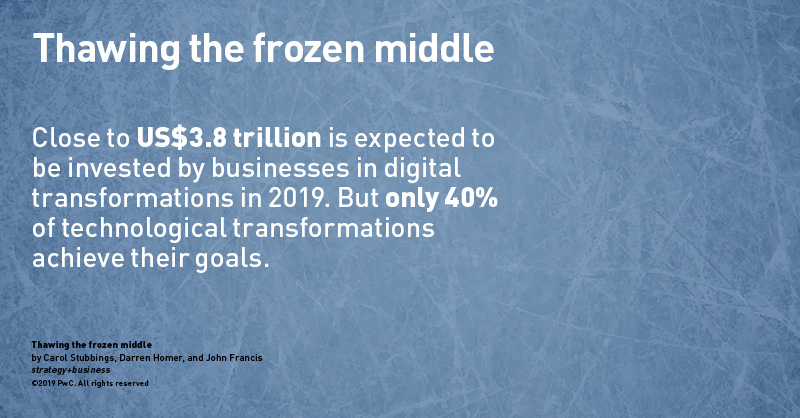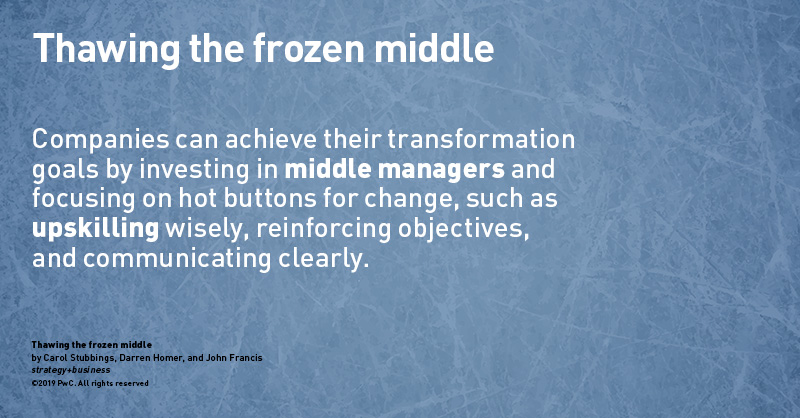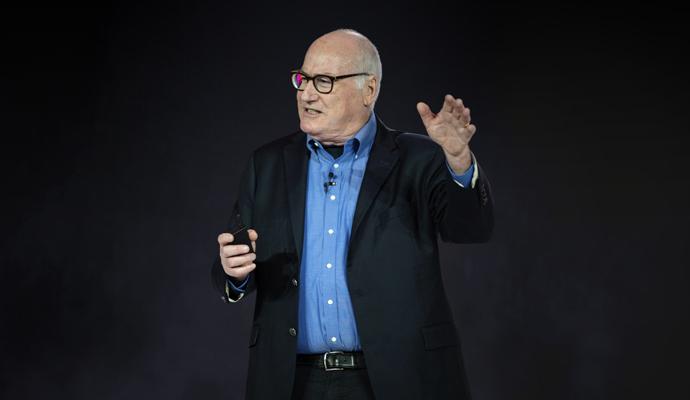Thawing the frozen middle
As businesses put trillions of dollars into digital transformations, they need a plan to ensure that middle management is helping make the most of the investment.
A version of this article appeared in the Spring 2020 issue of strategy+business.
Close to US$3.8 trillion is expected to be invested by businesses in digital transformations in 2019, up 3.2 percent on the previous year, as companies try to transform the way they work in the face of technological change, market disruption, and unrelenting competition. But one has to ask: What kind of bang are these companies getting for their buck? Global productivity is all but stagnant in the biggest economies, and barely half of organizational transformations and 40 percent of technological transformations achieve their goals. The urgency has never been greater for businesses to diagnose the problem and make the most of this capital spending: The pace of technological change shows no signs of slowing, but economic growth is hitting the brakes.
The assumption has always been that when something goes wrong with a transformation, it’s the implementation, rather than the original strategy, that’s at fault. Top management has a vision; the vision is translated into detailed plans. So far, so good. But somewhere along the way, the change stalls — and accusatory eyes turn to middle management. Yet there’s evidence that middle managers, who need to be the agents of any transformation, engaged in the right way, can deliver outstanding results.
The key is unlocking the skills that will produce the returns. We would argue that these skills are the ones that augment automation and are not replaced by it: emotional skills such as creativity, problem solving, and resilience. We would argue further that it’s not just middle managers who need upskilling in their ways of working. Leadership has to understand its role in motivating and incentivizing its workforce to embrace new ways of working and find ways to redeploy talent into value-creating activities once it is freed up by automation.
In his study of a major transformation program by a large telecom company, Quy Nguyen Huy, professor of strategy and management at INSEAD, found that approximately 80 percent of the 117 separate projects initiated by senior management had failed or had fallen short of expectations. In contrast, 80 percent of those initiated by middle managers had succeeded, bringing in $300 million in annual profits. In the right conditions, middle managers don’t block change — they drive it through. But they need the right kind of support.


Image problems
As anyone who has watched The Office knows, middle management has an image problem. The phrase conjures an anonymous group that can easily spill into caricature — disillusioned, passed over for promotion, declining in their importance to the organization, Luddites. The description of middle management used by Maile Carnegie, group executive of digital banking at ANZ Group in Australia, in a recent article is unsparing: “people in [the] organization who are no longer experts in a craft, and who have graduated from doing to managing and basically bossing other people around and shuffling PowerPoints.”
Leaders need to be aware of when these behaviors happen and try to understand the reason. They are missing an opportunity if they fail to see the skepticism or “stuck-ness” of middle management as a cultural issue that can be addressed and solved, and only believe it to be a universal truth that must be tolerated. Take the case of a major digital transformation PwC supported at a multinational retail bank. Within middle management were a subset of managers known as the “technical gurus” who had a shared tendency to overintellectualize and use technology jargon that complicated issues. Any attempt at change became bogged down in a complexity of their own making; coworkers confronted by the gurus’ tech-speak and resistance lost the will to live, let alone to see the transformation through. The core problem was the long-standing culture of the bank, in which technical expertise was highly valued, which meant the technical gurus were more likely to be listened to. That had the effect of obstructing the development of practical, workable solutions offered by nontechnical managers who didn’t have senior management’s ear.
Leaders are missing an opportunity if they fail to see the skepticism or ‘stuck-ness’ of middle management as a cultural issue that can be addressed and solved.
It’s clear that middle management is not a monolithic block. Some managers will put up barriers, or, as Carnegie says, “resist change like death.” Those on the front lines may have good reason to question the way leadership is going about change, even if they do not question the need for change itself. Others will embrace change. It’s important to understand what’s causing these reactions, because middle managers are the drivers of business performance.
INSEAD’s Quy Nguyen Huy describes middle managers’ contribution in three areas — all related to interpersonal human skills — that are essential for the implementation of transformation programs:
• Middle managers are far better than most senior executives at using informal organizational networks to bring about substantive, lasting change. They know more people and are closer to them, and are more influential than senior managers can ever hope to be.
• They are tuned in to the moods and emotional needs of employees, which helps them keep pushing change forward.
• They effectively manage the tension between change and the status quo — they keep the organization from falling into inertia, on the one hand, or chaos, on the other.
These are uniquely human attributes that can’t be replicated by machines. PwC’s research shows (pdf) that CEOs value emotion-based skills — leadership, resilience, problem solving, and creativity — but also that 77 percent of CEOs are struggling to find them. In many cases, middle manager change agents are likely to be down the hall — but leadership hasn’t been able to bring out the best in them. In a recent PwC survey of CEOs and HR managers, 55 percent of respondents said they had not taken action to create a clear narrative about the future of their workforce and automation. That omission creates uncertainty and resistance, not least because it often directly affects the people who are tasked with implementing the change. Digital transformation is an emotional and loaded issue for any workforce.
PwC’s economic analysis shows that one in three jobs is likely to be severely disrupted or to disappear in the next decade because of technological change. This could affect almost half of all low-skilled workers and a third of semiskilled workers, the very people middle managers oversee. And the middle managers themselves will find their roles changing, too. They may also feel that at their age or level of seniority, they do not need to acquire new skills. Long-standing managers have seen a lot of changes, have lived through a lot of trends, and know that not every new management initiative is going to be a success — far from it. For a middle manager of long tenure in a typical organization, waiting for things to revert to “normal” has often been a wise strategy. Additionally, some middle managers lack motivation. It’s difficult to throw passion and energy into reinventing an organization if you’ll be retired by the time the transformation is complete.
It’s not them, it’s you
But what if the middle managers really are like the David Brents/Michael Scotts of this world? Just a few frozen middle managers can set an organization on the road to failure, gradually and silently blocking progress like cholesterol in an artery until, one day, the blood flow stops. If an organization is not working as it should, ultimately the responsibility lies with its leadership. If a transformation effort stalls or fails, the problem may be that senior management has sabotaged middle management’s ability to implement the strategy, either by promoting the wrong people into the roles or not supporting the ones who can deliver change in the right way.
A research study (pdf) by Cansu Oral of St. Gallen University in Switzerland on the role that middle managers play in change programs used the example of Bayer CropScience (BCS) and its transformation strategy to show that even when an organization recognizes the importance of middle management in driving a successful transformation, leadership failings can still get in the way. In 2011, BCS, the second-largest global player in the US$65 billion agricultural science market, formulated a new strategy to address flatlining growth in a challenging market. The goal was “reinventing customer centricity along the entire value chain.” Its implementation plan included the selection and specialized training of 100 middle managers who would act as change agents.
Although BCS’s transformation was a success — annual revenue grew 43 percent over the three years following the new strategy — the challenges that middle managers reported all fell within the remit of senior management: They perceived a lack of leadership from the top, unrealistic time lines, and a lack of resources and change management skills in their teams. One manager complained of being “inundated” with templates and processes from the head office that didn’t add value at the local level, while another lamented that he “would love to see more…[of] senior management that really walks the talk.”
The study reported that over time, the BCS middle managers formed three distinct groups, showing that not all middle managers are frozen. Some were successful in implementing change and, as a result, were promoted; Oral credited their success to having senior managers who were clear about their roles and expectations. A second (and the biggest) group was made up of middling performers, integrating the change elements of their role into their daily business but failing to get the right support from leadership and therefore underperforming. And a third group failed. Some left the company, but others dug in and “acted resignedly in their roles, feeling frustrated.”
The hot buttons for change
Although every transformation program is different, five main areas warrant close attention if companies are to energize managers and teams. The first two will kick-start the process, but the remaining three need to be planned for and happen simultaneously.
1. Pinpoint the problem areas. At PwC, our approach is to diagnose team performance from all angles: We look at the formal KPIs that the company measures, and assess each team’s operational routines. How do teams communicate? How do they approach problem solving? Without a comprehensive diagnosis to find out whether it is a technology or people issue that is causing concern or stagnation, it won’t be possible to address the behaviors needed to bring about change.
We recently conducted a full diagnosis of a planned automation program for a financial-services organization. Senior managers were convinced they needed new technology. We used a digital simulation of their process to model the impact of various transformation efforts. The results showed that if the proposed automation were to be applied on certain processes without preparing the people, it would increase rather than decrease the costs of serving their clients.
It pays to plan the upskilling agenda for managers even before you start the transformation process so they have the confidence and skills to implement the strategy. Once needs are properly assessed from all angles, the work can begin to energize managers and teams and provide them with the skills and tools they need to push through change.
2. Identify agents for change — and let them lead. Take time to recognize middle managers as change agents and let them be the leaders of that change. Middle managers will not just activate a transformation program — they will know before anyone else whether it’s working or not. Their resistance to change, which might look like inertia to senior management, could in fact be a sign that the transformation initiative is failing to win people over. The message: Listen to them and trust them. It’s what Dan Cable in his book Alive at Work calls “freedom within the frame.” Leadership sets the strategy; managers and teams work out how to deliver it.
The BCS study concluded that the middle managers most successful in implementing change were those who performed strongly in four areas, all related to human skills:
• Their level of engagement with change initiators (i.e., top management)
• Their resilience (i.e., their ability to overcome team members’ resistance to change)
• Their ability to make sense of the change strategy
• Their willingness and ability to learn change skills.
Once these managers have the freedom to lead and the necessary support, they are more likely to come up with the solutions themselves.
A second set of change agents can also help; some will be middle managers, but middle managers will also recognize these informal leaders in their team. As Derek Sivers points out in his TED Talk “How to Start a Movement,” a formal leader, the one who instigates a movement, is the catalyst, but it’s the informal leaders, the very early adopters, who see the value in change and ultimately influence and decide whether it takes hold. Informal leaders tend to self-select, rather than be nominated. They participate of their own volition and lead by example. These are what Jon Katzenbach of the Katzenbach Center of Strategy&, PwC's strategy consulting business, calls “authentic informal leaders,” who should be celebrated and rewarded. Middle managers, with their close connection to their teams on the ground, are ideally placed to harness these informal leaders’ energy.
3. Upskill wisely. Leadership must make the case that acquiring new skills is essential. Everyone is faced with difficult trade-offs between doing a day job and learning new ways of working. Senior management needs to allocate time and support to make both happen. We define upskilling as the expansion of people’s capabilities and employability at times of change at an organizational, sector, or community level. It applies to everyone and is an effort to convert applicable knowledge into productive results by identifying the skills that are needed (particularly the soft skills that are essential to leading change), the people who could plausibly gain them, and the learning and training that could help.
When it comes to digital transformation, we often see technical skills emphasized to the detriment of leadership capabilities. At the middle management level, leadership agility is the most important skill of all — so focus on leadership fundamentals, problem-solving techniques, and operational excellence. Developing middle managers’ own coaching skills enhances the investment still further, because most team members prefer to be coached by highly effective managers. These managers will also need a degree of digital understanding to have the confidence to give their teams the support they need to innovate.
We used this approach while supporting a South African bank through a large-scale digital transformation. Investing heavily in raising the performance of team leaders produced impressive results: Revenues in one area rose by more than 20 percent, and people engagement scores rose by 25 percent. Furthermore, it simplified processes and ways of working, which laid the essential foundations for further technology-based transformation.
4. Communicate clearly. Middle managers responsible for implementing change need detailed engagement from senior management — a clear and compelling explanation of why the change is necessary, the objectives and benefits of the change, and an honest assessment of previous transformation programs that have failed.
The tone of communication matters. PwC’s David Lancefield and Sarah Isted have pointed out that emotional triggers work better than data when it comes to persuading people of the need for change. The two worked with a company that was suffering from high customer turnover and complaints, and that had formed a plan to improve its customer service processes. Senior management presented a 50-page “case for change” to its middle management team. It explained why an improvement in customer service processes would help the company, using a series of graphs that left the middle managers cold. Nothing changed.
The PwC team suggested that these middle managers visit the company’s customer contact center, where they listened in on calls with unhappy customers. Once they heard real, live dissatisfied customers, the managers saw the pressing need for change and discussed their own ideas to improve the way the center worked. Over time, team productivity increased by 70 percent, and customer retention rates improved. As neuroscientist Donald Calne has said, the difference between emotion and reason is that emotion leads to action, whereas reason leads to conclusions. Graphs and data have their place, but they can also remove people from reality: The real power comes in integrating emotional motivations with rational reasoning.
5. Reinforce the objective. Every transformation needs an objective. For the customers of the U.K.’s Sage Group, its decision to transform from a subscription-based software licensing service to a cloud-based service was driven by a business imperative in a competitive market. If Sage was going to maximize revenue, it needed to increase customer renewal rates. That meant that its customer service teams needed to reach as many key decision makers as possible. This wasn’t going to work unless the customers were engaged and informed — and the responsibility for achieving that lay with the middle layers of the company, those who acted as the contact points for customers. The metric measured was the level of customer engagement.
We introduced Sage to our digital performance management tool, which drives new behaviors to improve efficiency. As part of the approach, teams “huddled” for 15 minutes every day to talk about their individual performance metrics. This allowed them to see clearly whether they were on track to deliver the objectives of the customer program, share their milestones with their colleagues, and ask for help or advice if they needed it. These huddles showed staff that their performance was making a real difference to the business, and reinforced the point that customer engagement was the key metric by which they were measured. After 16 weeks of our working with the company, the teams were talking to 70 percent more customers than before, and customer renewal rates had increased by 2 percent.
Unlocking benefits
Thawing the frozen middle isn’t easy. But it’s more important than ever, given the large sums of capital being injected into digital transformation programs and the challenge of implementing technological advances quickly. According to PwC’s 22nd Annual Global CEO Survey, 85 percent of business leaders believe that artificial intelligence (AI) will change their business significantly in the next five years, and 35 percent intend to introduce AI initiatives by 2022. Return on these investments is top of mind, given the disappointments of transformations past and the increasing number of business failures. You can take costs out of a business and be vigilant about keeping up with the pace of change, but if you don’t have the talent to take advantage of the opportunities that transformation creates, productivity will not improve.
Transformation failures are not caused by one person or one single issue. By understanding the psyche of the middle management layer, CEOs can identify the levers that will work and unlock the benefits of transformation. It’s a matter of focusing on human capital and valuing the skills that their people have and can develop. They can then redeploy their creative, resilient, upskilled people to tackle more problems and create more value. Technology fundamentally changes the role of middle managers, and it simultaneously makes them even more important.
Author profiles:
- Carol Stubbings is the global leader of PwC’s people and organization practice. Based in London, she is a partner with PwC UK.
- Darren Homer works with global clients on transformations, concentrating on people performance. Based in London, he is a partner with PwC UK.
- John Francis specializes in the design and delivery of large transformation programs in financial services. Based in London, he is a director with PwC UK.




